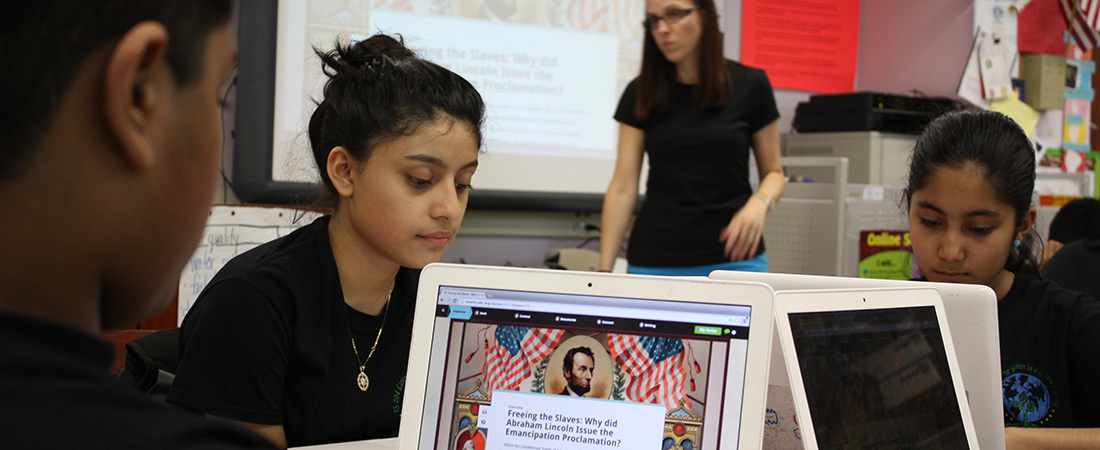Zooming In on History and Literacy

Social studies students use Zoom In to investigate and write about history.
With 10 years of experience under her belt, Jennie Bremer is confident that she knows how to teach history. But this year Bremer—the chair of the Social Studies Department at Travis Ranch Middle School in Yorba Linda, California, and a former Orange County Teacher of the Year—is responsible for helping the 235 eighth graders in her classes refine their writing, too, as part of the district’s adoption of the Common Core.
It’s a big change for Bremer, who is used to looking at the content, not the structure, of the essays that she grades. But she has found a free, innovative curriculum supplement that links social studies and literacy—EDC’s Zoom In.
“Before our current emphasis on writing and Common Core skills, a lot of students didn’t have a good sense of what history was about,” says Bremer. “They thought it was just a set of facts to know. Using the Zoom In materials has helped them realize that historians investigate, look at primary and secondary sources, and write.”
That twin emphasis on investigation and writing is a hallmark of Zoom In, a collection of 15 online mini-units that cover U.S. history topics from the American Revolution to the social movements of the 1960s. Funded by the Bill & Melinda Gates Foundation, Zoom In was developed by historians, teachers, and researchers from EDC and the City University of New York.
Each Zoom In mini-unit presents students with primary and secondary sources about a specific historical event and then offers them interactive tools and experiences to analyze what happened—and why.
For example, in one lesson that examines the lead-up to the American Revolution, students study Paul Revere’s famous engraving of the Boston Massacre, comparing it to historians’ accounts of the event. Using Zoom In, they can take notes, highlight text, and learn definitions of unfamiliar words in the documents they are reading. Then they write a three-paragraph essay explaining how the engraving served as propaganda for the American patriot cause.
“Many other social studies products focus on reading and shortchange the writing,” says EDC’s Noah Goodman, the director of teacher outreach for Zoom In. “But our approach really strives to support kids in writing effective arguments and explanations.”
Learning across disciplines
Zoom In’s approach complements the Common Core State Standards, which emphasize the building of literacy skills across the disciplines. It was also designed for social studies teachers, who are increasingly responsible for helping students develop their reading, writing, and analysis skills.
“Teachers across the country want their students to be able to read, write, and reason in ways the Common Core names,” says EDC’s Bill Tally, who led the development of Zoom In. “But over and over, we hear that students struggle most with the transition to argumentative writing. Zoom In does several things that help teachers tackle this writing challenge with kids.”
For example, each mini-unit contains a set of writing prompts that can help students build their arguments. Teachers can also see the different notes and comments that students have made on the primary sources, which helps them offer individualized instruction.
But for the Zoom In team, the most important aspect of the program is that the literacy skills are grounded in a deep study of history. Tally believes that developing students’ reading and writing skills can actually enhance authentic discussions of social studies—including conversations about why certain events happened and why they mattered.
“Teachers care about, and are responsible for, disciplinary knowledge as well as skills,” he says. “And while there are other document-based history units available online, teachers are usually left on their own to help students if and when they struggle to read and write about the documents. In Zoom In, teachers see something different—rich and demanding U.S. history content and high supports for reading and writing.”
For Bremer, it’s this combination of content and writing support that sets Zoom In apart.
“Zoom In really emphasizes deep thinking as well as explanatory and argumentative writing,” she says. “It gave all my students the scaffolds they needed to write well.”
And while they are becoming better writers, her students are learning to love history, too.
“When I told my students that we would be doing another Zoom In unit soon, they were all excited,” she says. “I couldn’t believe that they were all looking forward to writing about history.”